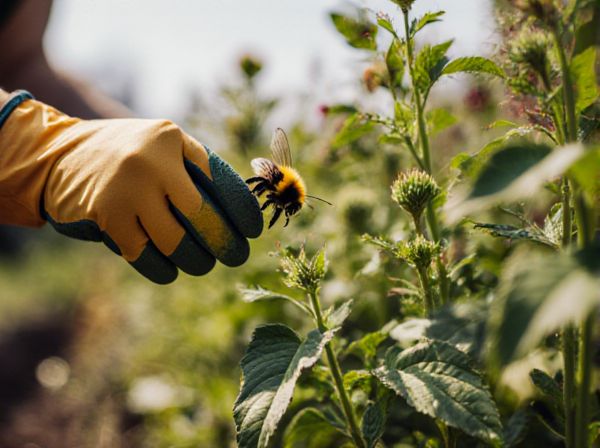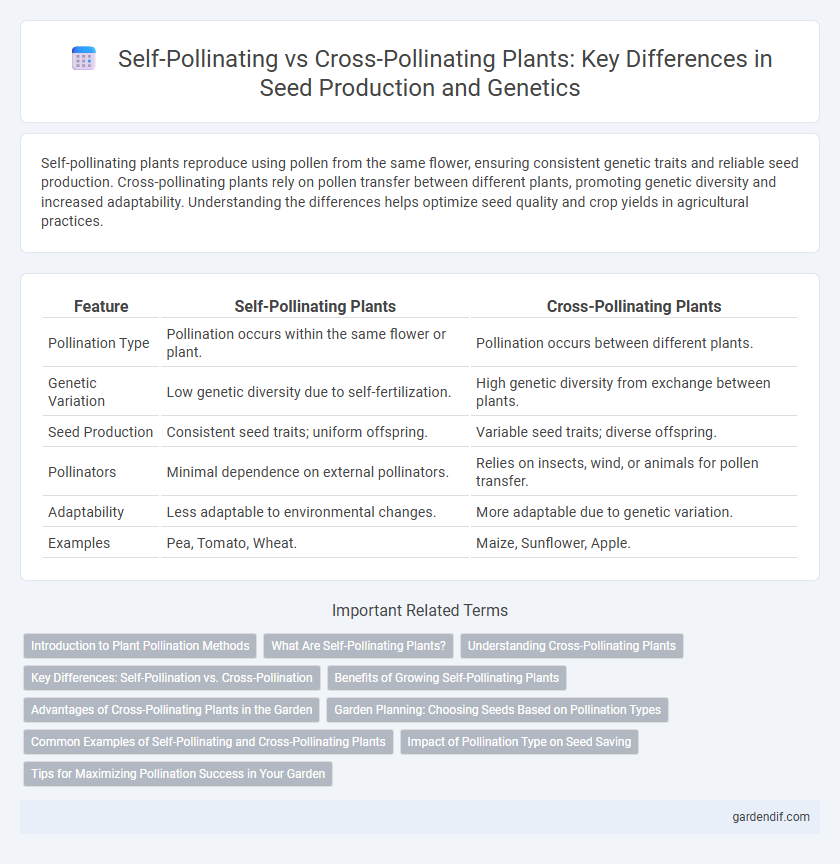
Self-pollinating plants vs Cross-pollinating plants Illustration
Self-pollinating plants reproduce using pollen from the same flower, ensuring consistent genetic traits and reliable seed production. Cross-pollinating plants rely on pollen transfer between different plants, promoting genetic diversity and increased adaptability. Understanding the differences helps optimize seed quality and crop yields in agricultural practices.
Table of Comparison
| Feature | Self-Pollinating Plants | Cross-Pollinating Plants |
|---|---|---|
| Pollination Type | Pollination occurs within the same flower or plant. | Pollination occurs between different plants. |
| Genetic Variation | Low genetic diversity due to self-fertilization. | High genetic diversity from exchange between plants. |
| Seed Production | Consistent seed traits; uniform offspring. | Variable seed traits; diverse offspring. |
| Pollinators | Minimal dependence on external pollinators. | Relies on insects, wind, or animals for pollen transfer. |
| Adaptability | Less adaptable to environmental changes. | More adaptable due to genetic variation. |
| Examples | Pea, Tomato, Wheat. | Maize, Sunflower, Apple. |
Introduction to Plant Pollination Methods
Self-pollinating plants transfer pollen from the anther to the stigma within the same flower, ensuring genetic consistency and reliable seed production in isolated conditions. Cross-pollinating plants depend on external agents like wind, insects, or animals to transfer pollen between flowers, promoting genetic diversity and improved adaptability. Understanding these pollination methods is crucial for optimizing seed breeding strategies and crop yields.
What Are Self-Pollinating Plants?
Self-pollinating plants are species that fertilize themselves using their own pollen, ensuring seed production without the need for pollen transfer from other individuals. Common examples include tomatoes, peas, and beans, which maintain genetic consistency across generations. This reproductive strategy provides reliability in seed development, especially in isolated or controlled environments.
Understanding Cross-Pollinating Plants
Cross-pollinating plants rely on pollen transfer between different individual plants, promoting greater genetic diversity and increased adaptability in varying environmental conditions. These plants often exhibit floral structures and mechanisms, such as colorful petals and nectar production, to attract pollinators like bees, butterflies, and birds, facilitating effective pollen exchange. Understanding cross-pollination enhances crop breeding strategies, improving yield, disease resistance, and overall plant vigor.
Key Differences: Self-Pollination vs. Cross-Pollination
Self-pollinating plants transfer pollen within the same flower, ensuring consistent traits and higher seed uniformity, while cross-pollinating plants rely on pollen from different flowers, promoting genetic diversity and adaptability. Self-pollination reduces the need for pollinators and environmental factors but may lead to inbreeding depression, whereas cross-pollination enhances hybrid vigor and resilience in offspring. Understanding these differences is crucial for crop breeding strategies and optimizing seed production.
Benefits of Growing Self-Pollinating Plants
Self-pollinating plants produce seeds without the need for pollen from another plant, ensuring consistent and reliable yields in controlled environments. These plants offer the benefit of genetic stability, leading to uniform crop quality and predictable growth patterns. Gardeners and farmers benefit from reduced dependency on pollinators and lower risk of pollen-borne diseases.
Advantages of Cross-Pollinating Plants in the Garden
Cross-pollinating plants generate greater genetic diversity, enhancing resilience against pests, diseases, and environmental stresses compared to self-pollinating varieties. This increased genetic variation often results in improved vigor, yield, and adaptability within garden ecosystems. Gardeners benefit from cross-pollinating plants by achieving healthier crops with a wider range of desirable traits.
Garden Planning: Choosing Seeds Based on Pollination Types
Self-pollinating plants like tomatoes and beans ensure consistent fruit production in smaller garden spaces by requiring only one plant to produce seeds, making them ideal for limited areas. Cross-pollinating plants such as squash and cucumbers rely on pollen transfer between separate plants, which promotes genetic diversity and often results in higher yields but requires planting multiple individuals. Garden planning should consider pollination types to optimize seed selection, spacing, and companion planting techniques for robust crop growth and seed saving success.
Common Examples of Self-Pollinating and Cross-Pollinating Plants
Self-pollinating plants such as tomatoes, peas, and wheat have flowers capable of fertilizing themselves, ensuring seed production without the need for pollen transfer between different plants. Common cross-pollinating plants include maize, apple trees, and sunflowers, which rely on external agents like wind or insects to transfer pollen between separate plants for fertilization. Understanding these examples highlights the differences in genetic diversity and reproduction strategies among plant species.
Impact of Pollination Type on Seed Saving
Self-pollinating plants produce genetically uniform seeds, ensuring consistent traits and greater predictability in subsequent generations, which simplifies seed saving for home gardeners. Cross-pollinating plants generate genetic diversity, increasing resilience to environmental stress but requiring isolation to prevent unwanted hybridization when saving seeds. Effective seed saving depends on understanding pollination mechanisms to maintain crop purity and desired plant characteristics.
Tips for Maximizing Pollination Success in Your Garden
Self-pollinating plants like tomatoes and peas require less space and provide reliable fruit set, while cross-pollinating plants such as cucumbers and squash depend on pollinators like bees for genetic diversity and higher yields. To maximize pollination success, plant diverse flowering species nearby to attract a variety of pollinators and ensure planting seasons overlap to support continuous pollinator activity. Regularly monitor plant health and avoid the overuse of pesticides to maintain a thriving pollinator population essential for effective cross-pollination.
Self-pollinating plants vs Cross-pollinating plants Infographic

 gardendif.com
gardendif.com